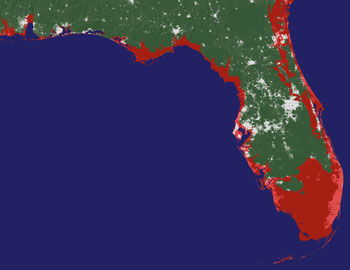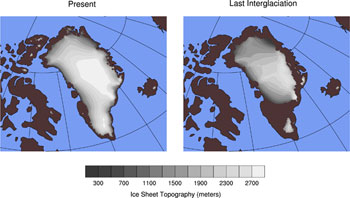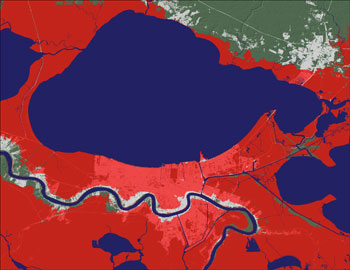If This Trend Continues What Will Eventually Happen to the Lake
Sea levels to rise 20 feet if ice melting trend continues
Rhett A. Butler, mongabay.com
March 23, 2006
New research says if current warming trends continue, the Greenland and Antarctic ice sheets are on track to melt sooner than previously thought, leading to a global sea level rise of at least 20 feet.
The study, published in the March 24 issue of the journal Science, projects that by 2100 the Earth will likely be at least 4 degrees Fahrenheit warmer than present, with the Arctic at least as warm as it was during the last interglaciation, 129,000 to 116,000 years ago, when sea levels were about 20 feet (six meters) higher than the present.
"This is a real eye-opener set of results," said Jonathan T. Overpeck, a geoscientist at the University of Arizona in Tucson and co-author of the paper. "The last time the Arctic was significantly warmer than present day, the Greenland Ice Sheet melted back the equivalent of two to three meters (about six to ten feet) of sea level."
The study, conducted by researchers from the U.S. National Center for Atmospheric Research (NCAR), the University of Arizona, the University of Colorado, and the University of Calgary, modeled its findings based on evidence collected from existing academic research on ice cores, ancient coral reefs, fossilized pollen, and cores from marine and lake sediments. The model suggests that during the past warming event, the Antarctic ice sheet also melted substantially, doubling the previously believed magnitude of rise in sea levels. By successfully recreating the last period of significant global warming using existing data, the scientists believe their model can forecast future climate change.
 The red and pink areas in this image of the state of Florida indicate the areas that would be submerged if the sea level rose about 20 feet (six meters). Courtesy of Jeremy Weiss and Jonathan Overpeck, The University of Arizona. |
"If the climate model is capable of reproducing a climate scenario that is consistent with the palaeological record, that gives us more confidence that it's also giving us reliable projections for the future," says Marshall, an associate professor in the University of Calgary Department of Geography and an author of the paper.
Recent observations from NASA has confirmed that ice sheets are melting already. The new research suggests that the melting could accelerate, raising sea levels three feet (about one meter) or more per century. Such a rise could have a devastating impact on low-lying coastal cities which would be more susceptible to the impacts of storm surge as well as suffering from potential disruption of sewage and transit systems.
While changes 130,000 years ago were likely gradual and resulted from an increase in solar radiation over the Arctic, caused by slight changes in the Earth-Sun orbit, the current rise is temperatures is thought to result from increased anthropogenic emissions of greenhouse gases, which have skyrocketed since the beginning of the Industrial Revolution.
 The red and pink areas in this image of the coasts of the states of Massachusetts and Rhode Island indicate the areas that would be submerged if the sea level rose about 20 feet (six meters). Courtesy of Jeremy Weiss and Jonathan Overpeck, The University of Arizona. An image of the area around New Orleans, La., with the water shown in blue. The portions of the image colored pink and red represent areas that would be submerged if sea level rose about three feet (one meter). Courtesy of Jeremy Weiss and Jonathan Overpeck, The University of Arizona. |
"Unless something is done to dramatically reduce human emissions of greenhouse gas pollution," said Peck "we're committed to four-to-six meters (13 to 20 feet) of sea level rise in the future."
Arctic, Antarctic Melting May Raise Sea Levels Faster than Expected
National Center for Atmospheric Research News Release
BOULDER—Ice sheets across both the Arctic and Antarctic could melt more quickly than expected this century, according to two studies that blend computer modeling with paleoclimate records. The studies, led by scientists at the National Center for Atmospheric Research (NCAR) and the University of Arizona, show that Arctic summers by 2100 may be as warm as they were nearly 130,000 years ago, when sea levels eventually rose up to 20 feet (6 meters) higher than today.
Bette Otto-Bliesner (NCAR) and Jonathan Overpeck (University of Arizona) report on their new work in two papers appearing in the March 24 issue of Science. The research was funded by the National Science Foundation, NCAR's primary sponsor. The study also involved researchers from the universities of Calgary and Colorado, the U.S. Geological Survey, and The Pennsylvania State University.
Otto-Bliesner and Overpeck base their findings on data from ancient coral reefs, ice cores, and other natural climate records, as well as output from the NCAR-based Community Climate System Model (CCSM), a powerful tool for simulating past, present, and future climates.
"Although the focus of our work is polar, the implications are global," says Otto-Bliesner. "These ice sheets have melted before and sea levels rose. The warmth needed isn't that much above present conditions."
The two studies show that greenhouse gas increases over the next century could warm the Arctic by 5-8°F (3-5°C) in summertime. This is roughly as warm as it was 130,000 years ago, between the most recent ice age and the previous one. The warm Arctic summers during the last interglacial period were caused by changes in Earth's tilt and orbit. The CCSM accurately captured that warming, which is mirrored in data from paleoclimate records.
 This graphic shows the height of the Greenland ice sheet at present (left) and during the last interglacial (about 130,000 years ago), as simulated by the NCAR-based Community Climate System Model coupled with an ice-sheet model. (Illustration courtesy Bette Otto-Bliesner, NCAR.) RELATED ARTICLES Global warming causing stronger hurricanes 03/16/2006 Record one-year increase in carbon dioxide levels 03/13/2006 Warming climate causing biological changes in the Arctic 03/10/2006 Slowing global warming may be less costly than initially thought 03/09/2006 Global warming may cause 11-inch rise in sea levels by 2100 01/26/2006 |
Although simulation results depend on the assumptions and conditions within different models, estimates of warming from the CCSM are within the range projected by other climate models, according to the authors.
"Getting past climate change correct in these models gives us more confidence in their ability to predict future climate change," says Otto-Bliesner.
The CCSM suggests that during the interglacial period, meltwater from Greenland and other Arctic sources raised sea level by as much as 11 feet (3.5 meters), says Otto-Bliesner. However, coral records indicate that the sea level actually rose 13 to 20 feet (4-6 meters) or more. Overpeck concludes that Antarctic melting must have produced the remainder of the sea-level rise.
These studies are the first to link Arctic and Antarctic melting in the last interglacial period. Marine diatoms and beryllium isotopes found beneath the West Antarctic Ice Sheet indicate that parts of the ice disappeared at some point over the last several hundred thousand years.
Overpeck theorizes that the rise in sea levels produced by Arctic warming and melting could have helped destabilize ice shelves at the edge of the Antarctic ice sheet and led to their collapse. If such a process occurred today, it would be accelerated by global-scale greenhouse-induced warming year round, Overpeck says. In the Arctic, melting would likely be hastened by pollution that darkens snow and enables it to absorb more sunlight.
In the last few years sea level has begun rising more rapidly, now at a rate of about an inch per decade, says Overpeck. Recent studies have also found accelerated rates of glacial retreat along the margins of both the Greenland and West Antarctic ice sheets.
This article used information and quotes from news releases from the University of Arizona, the University of Calgary, and the National Center for Atmospheric Research.
Source: https://news.mongabay.com/2006/03/sea-levels-to-rise-20-feet-if-ice-melting-trend-continues/


0 Response to "If This Trend Continues What Will Eventually Happen to the Lake"
Post a Comment